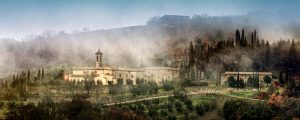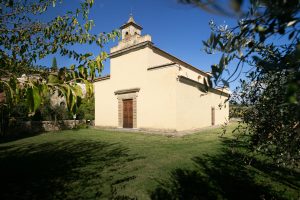BY CLAUDIA CIABATTINI
In the municipality of Radda in Chianti, along the SP 114 called the “Traversa del Chianti” there is a small Romanesque church dedicated to Santa Maria Novella: most likely erected in the 10th century, it represents a perfect example of Romanesque architecture. Inside, the frescoed ribbed vaults and the magnificent pillars alternating with columns are absolutely striking.

The first historical evidence is found in a parchment of 1010 preserved in the Abbey of San Lorenzo in Coltibuono, in that document it is called plebes Sanctae Mariae quae dicitur Novella – the term novella in the Middle Ages was used to indicate a new piece of cultivated land.
 The lords of the Monterinaldi Castle had patronage over the parish. Their control over the parish is attested by a document dating back to 1043 with which Landolfo, a member of the family, gave his wife Aldina the fourth part of his possessions, including the parish church of Santa Maria Novella.
The lords of the Monterinaldi Castle had patronage over the parish. Their control over the parish is attested by a document dating back to 1043 with which Landolfo, a member of the family, gave his wife Aldina the fourth part of his possessions, including the parish church of Santa Maria Novella.
Later the patronage of the church passed to other noble families until the 13th century when it was acquired by one of the territorial republics of Florence, since in addition to the sacred functions there were also others, such as the maintenance of the roads.
The role of the parish church in the following centuries slowly diminished in importance: in the 14th century it was included in the Terziere di Radda, one of the three districts that formed the Lega del Chianti and this situation continued until the 18th century when, following reforms, leagues were disbanded and modern communities were born.
Outside, the church looks like a basilica with three naves, very sober, there are only two windows on the sides, since neither the facade nor the tribune have openings. The three apses are clearly visible in the gallery.
 The church was almost entirely rebuilt in the 19th century and the characteristics of its Romanesque architecture changed profoundly: presently only the foundations of the church and the bell tower are from the Romanesque period.
The church was almost entirely rebuilt in the 19th century and the characteristics of its Romanesque architecture changed profoundly: presently only the foundations of the church and the bell tower are from the Romanesque period.
Inside, the ribbed vaults and frescoed walls dominate. At the top of each column there are majestic capitals of different shapes and patterns, skilfully worked by the Valdarno masters.
The most striking work of art is the hexagonal baptismal font made by the master Santi Buglioni. The gilded copper cross dates back to around the 12th century and behind the magnificent glazed ceramics there are two Renaissance tabernacles in pietra serena.
 The particularity of this church and the fabulous landscape in which it is located make it a perfect destination for those who want to combine a day full of history and architecture with a wonderful excursion into the heart of Chianti.
The particularity of this church and the fabulous landscape in which it is located make it a perfect destination for those who want to combine a day full of history and architecture with a wonderful excursion into the heart of Chianti.
Info: Ufficio Informazioni Pro Loco Radda, Piazza Castello, Tel. 0577 738494 (Silvia Brogi)/ proradda@chiantinet.it/ www.comune.radda-in-chianti.si.it/www.visitchianti.net
